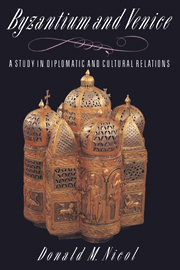Book contents
- Frontmatter
- Contents
- Dedication
- Preface
- List of abbreviations
- Maps of the Byzantine and Venetian worlds
- 1 Venice: the Byzantine province
- 2 Venice: the Byzantine protectorate
- 3 Venice: the ally of Byzantium
- 4 Venice: the partner of Byzantium
- 5 Byzantium, Venice and the First Crusade
- 6 The parting of the ways
- 7 The calm before the storm
- 8 The Fourth Crusade
- 9 Venice in Byzantium: the Empire of Romania
- 10 Venice: champion of a lost cause
- 11 Byzantium, Venice and the Angevin threat
- 12 Byzantium, Venice and Genoa
- 13 Conflicting interests and competing claims
- 14 Byzantium, Venice and the Turks
- 15 Byzantium: the victim of commercial rivalry
- 16 The profit and honour of Venice
- 17 Jewels for an island
- 18 Byzantium in thrall to the Turks and in debt to Venice
- 19 Byzantine optimism and Venetian vacillation
- 20 Byzantium the suppliant of Venice
- 21 The worst news for all of Christendom: Venice and the fall of Constantinople
- 22 Legacies and debts
- Byzantine Emperors
- Doges of Venice
- Bibliography
- Index
7 - The calm before the storm
Published online by Cambridge University Press: 01 April 2010
- Frontmatter
- Contents
- Dedication
- Preface
- List of abbreviations
- Maps of the Byzantine and Venetian worlds
- 1 Venice: the Byzantine province
- 2 Venice: the Byzantine protectorate
- 3 Venice: the ally of Byzantium
- 4 Venice: the partner of Byzantium
- 5 Byzantium, Venice and the First Crusade
- 6 The parting of the ways
- 7 The calm before the storm
- 8 The Fourth Crusade
- 9 Venice in Byzantium: the Empire of Romania
- 10 Venice: champion of a lost cause
- 11 Byzantium, Venice and the Angevin threat
- 12 Byzantium, Venice and Genoa
- 13 Conflicting interests and competing claims
- 14 Byzantium, Venice and the Turks
- 15 Byzantium: the victim of commercial rivalry
- 16 The profit and honour of Venice
- 17 Jewels for an island
- 18 Byzantium in thrall to the Turks and in debt to Venice
- 19 Byzantine optimism and Venetian vacillation
- 20 Byzantium the suppliant of Venice
- 21 The worst news for all of Christendom: Venice and the fall of Constantinople
- 22 Legacies and debts
- Byzantine Emperors
- Doges of Venice
- Bibliography
- Index
Summary
The year 1171 marks a turning-point in relations between Byzantium and Venice. The Venetians could never forgive the Emperor Manuel for his high-handed action in arresting and imprisoning thousands of their citizens. Nor could they tolerate his deliberate favouritism of their commercial rivals, the Pisans and the Genoese. They felt embittered and betrayed. The attack on the Genoese quarter in Constantinople in 1170 had been the work of local mobsters. It had not been inspired by the Doge and people of Venice; and the emperor had gone too far in punishing all Venetians throughout his empire. By no means all of them were guilty of the crime. Yet many of those who were innocent, who had by their own profitable enterprise been contributing to the wealth of Byzantium, were ruined and bankrupted as a consequence.
The career of one such Venetian entrepreneur in the Levant is exceptionally well documented. He was that Romano Mairano who contrived the escape of some of his countrymen from Constantinople in March 1171. Romano was one of the nouveaux riches of Venice in the middle of the twelfth century. He married well and invested his wife's substantial dowry in his business ventures overseas. From 1153 he was engaged in trade between Venice and the ports of the Byzantine Empire, at Halmyros and Sparta. In 1155 he took a cargo of timber from Venice to Constantinople and set up a business in the capital which he made his headquarters for the next ten years. It was a family concern.
- Type
- Chapter
- Information
- Byzantium and VeniceA Study in Diplomatic and Cultural Relations, pp. 104 - 123Publisher: Cambridge University PressPrint publication year: 1989



